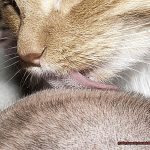Do you have a furry feline friend at home? Are you also an indoor plant enthusiast? Then, the question on your mind might be: are indoor palm trees safe for cats? It’s a dilemma that has plagued pet owners and green thumbs alike for years.
Cats are naturally curious creatures, and they love to explore their surroundings. Unfortunately, this can sometimes lead them to nibble on plants that could be harmful to their health. Palm trees are no exception. They may add a tropical touch to your living room, but is it worth the risk?
In this blog post, we’ll delve into the world of indoor palm trees and explore which ones are safe for your furry companion and which ones you should avoid. We’ll take a closer look at popular varieties such as the Areca Palm, Lady Palm, and Parlor Palm. We’ll also discuss the potential dangers these plants pose to your cat’s well-being.
But don’t worry – we won’t leave you hanging. We’ll provide you with a comprehensive list of cat-friendly palm trees that will keep both you and your feline friend happy.
So whether you’re a seasoned plant expert or just starting out with indoor gardening, join us in discovering everything there is to know about keeping your cat safe around these leafy beauties.
Are Palm Trees Toxic to Cats?
You might be wondering whether these plants are safe for your feline friend. As an expert in this topic, I can assure you that while most palm trees are not toxic to cats, there are a few exceptions that you should be aware of.
The good news is that some of the most popular indoor palm trees are non-toxic to cats. The Areca palm and the Bamboo palm are both safe options that can add some decorative flair to your home while also purifying the air. However, it’s important to make sure that the specific type of palm tree you have in your home is non-toxic to your cat.
While most indoor palm trees are safe for cats, there are a few that you should avoid. The Sago palm is one of the most toxic plants for cats and can cause severe health issues such as liver failure and even death. The Majesty palm is another variety that can be toxic to cats, causing vomiting and diarrhea if ingested.
Apart from toxicity concerns, there are some other things to keep in mind when it comes to indoor palm trees and cats. The fronds of these plants can be tempting for curious cats to play with and chew on, which could cause digestive issues or injuries. Additionally, some potting soils may contain fertilizers or chemicals that can be harmful to cats if ingested. It’s also important to regularly inspect your indoor plants for pests that could harm your cat.
Potential Hazards of Palm Trees for Cats
Indoor palm trees seem like a great way to bring a touch of the tropics into your home, but before you do so, it’s important to know about the potential hazards that these plants can pose to your cat.
One of the biggest concerns when it comes to indoor palm trees is their toxicity. Certain varieties, like the sago palm, are highly toxic to cats and can cause serious health issues if ingested. Symptoms of poisoning can include vomiting, diarrhea, lethargy, and even liver failure in severe cases. It’s essential to choose non-toxic varieties and keep them out of reach of your curious cat.
In addition to toxicity, indoor palm trees also have sharp leaves that can cause injury if your cat accidentally brushes up against them or tries to climb the plant. These slender leaves with pointed tips can result in puncture wounds or even eye injuries. So be sure to keep your cat away from these dangerous plants.
Lastly, indoor palm trees can present a choking hazard for curious cats. The small berries or seeds that some varieties produce may be enticing to cats but can become lodged in their throat, leading to choking or other respiratory issues. It’s best to keep a watchful eye on your furry friend and make sure they don’t get too curious around these plants.
To ensure the safety of your feline friend, take precautions when bringing indoor palm trees into your home. Choose non-toxic varieties and keep them out of reach of your cat. Additionally, monitor your cat’s behavior around the plants and inspect them regularly for any signs of damage or pests.
Inspecting the Soil in Indoor Plants
Cats are curious creatures that tend to explore and nibble on plants, so inspecting the soil in indoor plants is vital.
To begin with, it’s essential to check the label on fertilizers or chemicals used in the plant’s care. Look out for warnings about toxicity to animals. If you’re unsure about a particular product, it’s always best to err on the side of caution and avoid using it altogether.
Next, check the moisture level of the soil. Overwatering can lead to mold growth, which can be harmful to cats if ingested. Stick your finger about an inch deep into the soil. If it feels dry, it’s time to water the plant. If it feels moist or wet, hold off on watering for a few days.
If you notice any mold growth or unusual discoloration in the soil, it may be time to repot your plant. Inspect the roots for any signs of rot or damage before replacing the soil with fresh potting mix and replanting your palm tree.
Besides regular inspections, there are steps you can take to make indoor palm trees safer for cats. For instance, consider placing a barrier around the plant, such as a decorative fence or rocks, to prevent your cat from accessing the soil. Providing alternative sources of vegetation like cat grass or catnip can also deter them from chewing on your plants.
Attracting Insects and Pests
Picture this: you’ve brought home a beautiful indoor palm tree to add a touch of tropical paradise to your living space. But before you know it, unwelcome guests start creeping in. Yes, we’re talking about insects and pests. Don’t worry, we’ve got you covered. Let’s explore the common pests that can be found on indoor palm trees and how to prevent them from infesting your plant.
Spider mites are sneaky little critters that can be difficult to spot with the naked eye. However, their presence can be identified by the webbing they leave behind on the leaves. Mealybugs are another pesky pest that suck sap from the leaves and stems of your indoor palm tree, leaving small white dots in their wake. Scale insects are another type of pest that attach themselves to the leaves and stems while feeding on sap, causing yellowing and attracting ants. Lastly, aphids come in a variety of colors such as green, black, and brown and feed on the sap of your indoor palm tree.
To prevent these pests from infesting your indoor palm tree, it’s crucial to provide proper care and maintenance. Regular watering, fertilizing, pruning, and dusting off the leaves will remove debris or dust that can attract pests. And let’s not forget regular inspections. This will help you quickly identify signs of pest infestation so you can take immediate action.
If you do notice signs of pest infestation on your indoor palm tree, don’t panic. There are several natural remedies you can try before resorting to chemical pesticides. For example, spraying a mixture of water and dish soap on the leaves can help kill off spider mites and other insects. Alternatively, wiping down the leaves with rubbing alcohol or neem oil can get rid of mealybugs and other pests.
Taking Precautions with Indoor Palms
Many types of palm trees secrete oils that can be toxic to cats if ingested, leading to symptoms ranging from mild vomiting and diarrhea to severe liver failure.
Fortunately, there are several steps you can take to ensure your cat’s safety around indoor palms. Firstly, it’s essential to choose the right type of palm tree. Some varieties, such as the Kentia Palm or the Bamboo Palm, are considered non-toxic to cats and can be safely kept indoors. It’s always wise to research before purchasing any new plants and ensure they are safe for your pets.
Another precaution you can take is to keep indoor palms out of your cat’s reach. Placing plants on high shelves or using plant hangers can help keep them away from curious kitties. You can also train your cats not to chew on plants by using deterrents such as bitter apple spray or placing citrus peels around the base of the plant.
Regularly inspecting your indoor palms for any signs of damage or disease is also crucial. If a plant is showing signs of distress, such as wilted leaves or discoloration, it may be producing more of the toxic oils that can harm cats. In this case, it’s best to remove the plant from your home immediately.
Enjoying the Beauty of Indoor Palms Safely
Fear not, with a little research and some easy precautions, you can enjoy the beauty of indoor palms without jeopardizing your cat’s health.
The first step to safely enjoy indoor palm trees is to research the specific species you plan to bring into your home. While most indoor palms are safe for cats, a few species can be toxic if ingested. For example, the sago palm is highly toxic and can cause liver failure, vomiting, and diarrhea if eaten. On the other hand, the majesty palm and areca palm are considered non-toxic to cats.
If you already have an indoor palm tree and aren’t sure about its toxicity level, seek advice from your veterinarian or a plant expert. Better safe than sorry when it comes to your cat’s well-being.
Apart from toxicity concerns, cat owners must consider other potential hazards associated with indoor palm trees. For instance, some species have sharp fronds that can injure curious cats. Additionally, if a cat chews on the leaves of a palm tree, it could potentially cause an obstruction in their digestive system.
To prevent accidents or injuries, it’s best to keep indoor palm trees out of your cat’s reach or supervise them when they’re near these plants. You can also use deterrents such as bitter sprays or barriers to discourage your cat from chewing on the leaves.
Remember that prevention is key when it comes to keeping your cat safe around indoor palms. Regularly examine your plants for signs of distress such as yellowing leaves or wilting fronds and act promptly if you notice any issues.
Conclusion
In conclusion, indoor palm trees can be a stunning addition to your home décor, but it’s important to keep in mind the safety of your beloved feline friends. While most indoor palm trees are safe for cats, some varieties can be toxic and pose a serious threat to their health. Therefore, it’s crucial to do your research before bringing any indoor plants into your home.
Apart from toxicity concerns, indoor palm trees can also present other hazards such as sharp fronds that may harm curious cats or small berries that could get stuck in their throat. Regular inspections and preventative measures like barriers or deterrents can help ensure your cat’s safety around these plants.
It’s equally essential to inspect the soil in indoor plants regularly and avoid using fertilizers or chemicals that could be harmful if ingested by cats. Proper care and maintenance are critical in preventing pest infestations that could harm both your plant and your furry friend.
By taking necessary precautions and choosing the right type of indoor palm tree, you can safely enjoy the beauty of these tropical plants without compromising your cat’s health. Remember that prevention is always better than cure, so keep an eye on your feline companion and take prompt action if you notice any issues.







